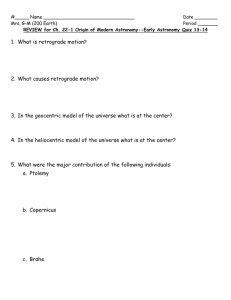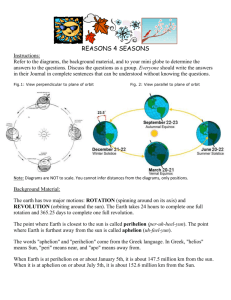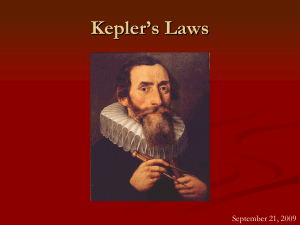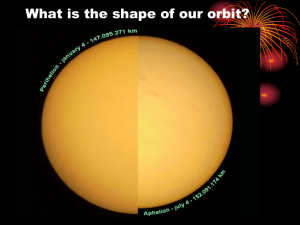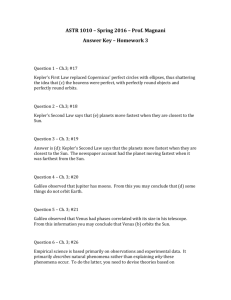Johannes Kepler
advertisement
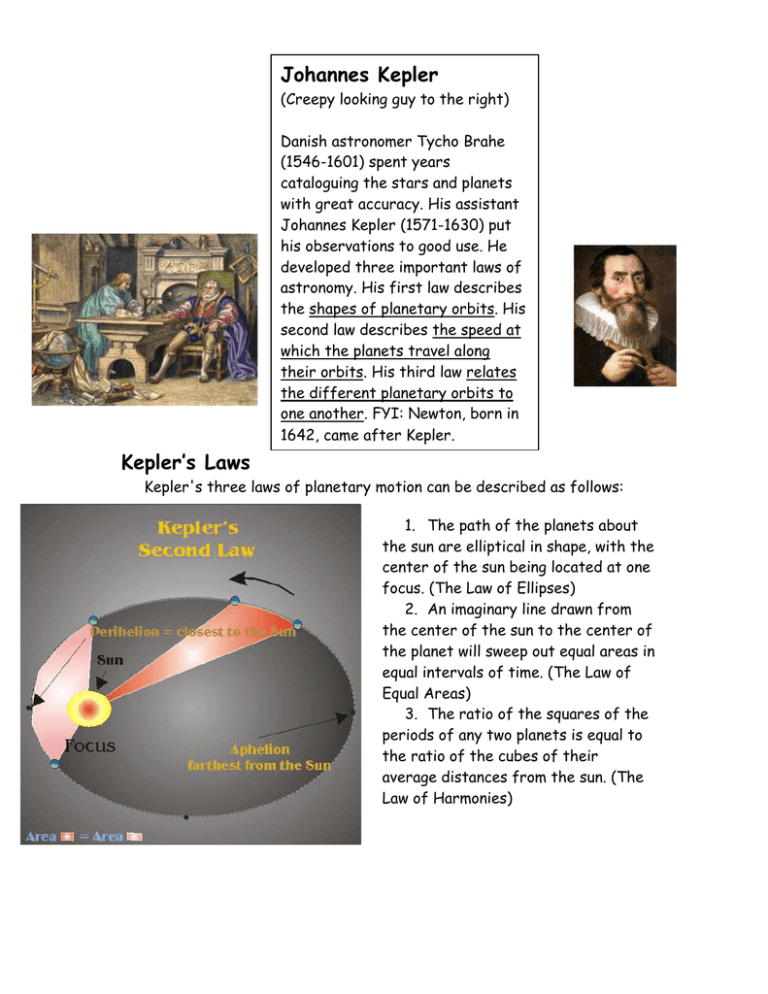
Johannes Kepler (Creepy looking guy to the right) Danish astronomer Tycho Brahe (1546-1601) spent years cataloguing the stars and planets with great accuracy. His assistant Johannes Kepler (1571-1630) put his observations to good use. He developed three important laws of astronomy. His first law describes the shapes of planetary orbits. His second law describes the speed at which the planets travel along their orbits. His third law relates the different planetary orbits to one another. FYI: Newton, born in 1642, came after Kepler. Kepler’s Laws Kepler's three laws of planetary motion can be described as follows: 1. The path of the planets about the sun are elliptical in shape, with the center of the sun being located at one focus. (The Law of Ellipses) 2. An imaginary line drawn from the center of the sun to the center of the planet will sweep out equal areas in equal intervals of time. (The Law of Equal Areas) 3. The ratio of the squares of the periods of any two planets is equal to the ratio of the cubes of their average distances from the sun. (The Law of Harmonies) The Orbit Lab Objective: The student will draw an ellipse to simulate the orbit of a planet and then analyze how the gravitational force varies with position in the orbit. Important terms: Perihelion Aphelion Materials: 2 thumbtacks, 21 cm x 28 cm piece of cardboard, Sheet of unlined paper, 30 cm of string or thread Procedure: 1. Push the thumbtacks into the paper and cardboard so that they are between 6 and 10 cm apart. 2. Make a loop with the string. Place the loop over the two thumbtacks. Keep the loop tight as you draw the ellipse. 3. Remove the tacks and string. Draw a small star centered as one of the tack holes. Observation and Data: 1. Draw the position of the planet in the orbit where it is farthest from the star. 2. Draw the position of the planet when it is nearest the star. 3. Determine the distance from these positions to the star’s center (below). Analysis: 1. Choose one of the planets in the solar system. 2. Calculate the gravitational force when the planet is at perihelion and aphelion. You will need to use the enclosed charts to find the distances and masses required. Draw your planet at the perihelion and aphelion distances and label the force vectors accordingly. 3. Draw your planet at two additional phases. Draw the tangential velocity vector at each phase (all four phases). NAME MASS (kg) Sun Mercury Venus Earth Mars Jupiter Saturn Uranus Neptune Pluto 1.991 x 1030 3.2 x 1023 4.88 x 1024 5.979 x 1024 6.42 x 1023 1.901 x 1027 5.68 x 1028 8.68 x 1026 1.03 x 1026 1.2 x 1022 PLANETARY DATA PERIHELION APHELION DIST. DIST. (megamiles) (megamiles) PERIHELION Date APHELION Date 28.6 66.8 91.4 128.4 460.3 837.6 1699.0 2771.0 2756.0 10/16/95 8/11/95 12/21/95 2/19/96 5/5/99 5/26/03 3/1/2050 3/2030 8/1989 11/29/95 12/1/95 6/21/96 1/28/97 3/29/2005 2/8/2018 4/17/2008 2/2112 8/2113 43.4 67.7 94.5 154.9 507.2 936.2 1868.0 2819.0 4555.0 AP Physics 1 Mr. Kuffer Orbit Lab – Your Ellipse NAME:_________________ Period: ________ *Show all work below. This should include several conversion for aphelion and perihelion from Megamiles to meters and the gravitational force of attraction at those two points. Every number should have a unit attached to it. If it does not… IT IS WRONG! Recall: 1 megamile = _______ x 106 miles 1 mile = 1609 m Planet Chosen: _______________________ Distance at Aphelion: Distance at Perihelion: Difference in Distance: Fg at Aphelion: Fg at Perihelion: Difference in Fg: *Now visit https://www.youtube.com/watch?v=zNeFI_JCXlY&app=desktop. Using concept over computation, add components necessary to exemplify, explain and defend Kepler’s Laws. This will require you to add key elements to the diagram on the previous page. Determining Planetary Gravitational Forces Instructions: Using the data in your packet, complete the following chart. Make sure you change miles to meters and do not forget to square the distance in the denominator. Fg = Gm1m2/ d2 Planet Mercury Venus Earth Mars Jupiter Saturn Uranus Neptune Pluto Fg @ Perihelion (N) Fg @ Aphelion (N) Application of Kepler’s 3rd and Universal Gravitation 1. Jupiter is 5.2 times farther than Earth is from the sun. Find Jupiter’s period in Earth years. 2. Uranus requires 84 years to circle the sun. Find Uranus’ orbital radius as a multiple of Earth’s orbital radius. 3. A satellite is placed in an orbit with a radius that is half the radius of the moon’s orbit. Find its period in units of the period of the moon. 4. An apparatus like the one Cavendish used to find G has a large lead ball that is 5.9 kg in mass and a small one that is 0.047 kg. Their centers are separated by 0.055 m. Find the force of attraction between them.
